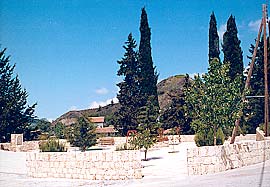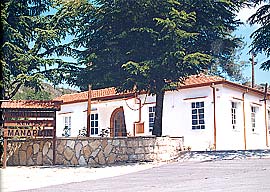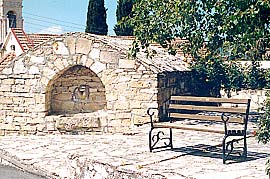 |
 |
 |
 |
 |
|
The village of Mandria is located about 35 kilometers northwest of the city of Limassol and is connected with Pano Platres in the northeast, with Pera Pedi in the southeast, with Omodos in the southwest and with Agios Nikolaos in the west.
The village is built upon mountainous territory at an average altitude of 830 meters. Narrow, deep valleys and high mountaintops -with heights that reach up to a thousand meters -characterize the terrain of the village. The tributaries of the river Cha-potami that flow in the region fragment the landscape. Mandria receives a very high average annual rainfall, reaching up to 800 millimeters; winemaking varieties of vines, and various fruit trees (apple trees, pear trees, cherry trees, plum trees, and quince trees), as well as walnut trees, olive trees, locust trees, and almond trees are cultivated in the area. Stockbreeding is very limited in the village.
The village has undergone many fluctuations of its population. In 1881 the inhabitants of the village numbered 282, increasing to 382 in 1901 and to 446 in 1911. In 1921 the population decreased to 418 and in 1931 to 409. The urban pull phenomenon that started hitting all the villages of Cyprus also hit Mandria, resulting in a decrease of population to 323 in 1946 and to 272 in 1960. In 1973 the population decreased to 235 and in 1982 to 158. Today the permanent inhabitants number 150. During the months of summer an increase of population is observed, reaching a peak during the month of August when the population can reach up to 1500. The development of tourism has not affected Mandria to a great degree, in spite of the fact that it is very close to the known tourist resorts of Troodos. Even today it preserves its picturesque quality and all the projects carried out in it blend in with the natural environment of the village. Mandria is one of those villages that have developed during recent years. Of course, it existed even during the era of the Turkish domination and it can be found marked on old maps under the name of Mandala or Mandalo. Most probably the village was in existence even before that as a small settlement of shepherds, just as its name proves. The name comes from the fact that -initially -only a few small folds (mandres) existed there; consequently Mandria meant "a venue with folds".
However, during the era of the Turkish domination it grew because of the many people arriving from a large, nearby settlement that was abandoned. That settlement was the one called Milavri, included in censuses of the Venetian era. (De Masse Latri cites it as Milari). We do not know the reasons for the abandonment of Milavri, however, what is considered most probable is that its inhabitants abandoned it after an epidemic that broke out so as to save themselves from it. Then most of them found refuge in the nearby Mandria, which probably was a territory of theirs to begin with. The Church of the village is dedicated to St. George. Gunnis (1935) makes a specific reference to the upper place -set apart for women -of this church, vividly painted with scenes from the Old Testament.
|
||||||||||||||||||||||||||



